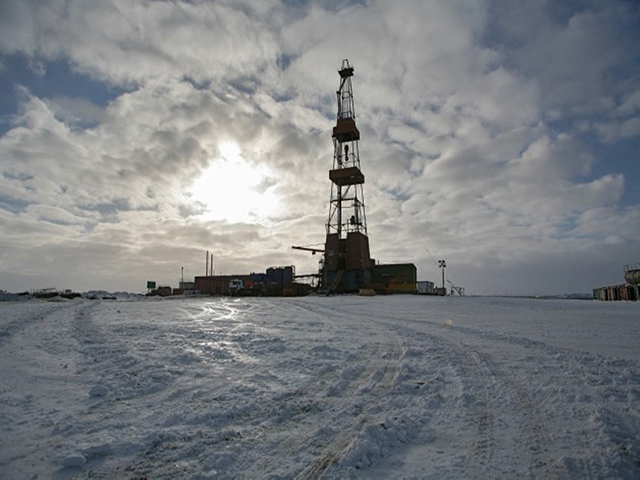
Russia’s largest oil field, so far past its prime that it now pumps almost 20 times more water than crude, could be on the verge of gushing profits again for Rosneft.
Samotlor, the 25 billion-barrel giant that bankrolled the Soviet Union for decades, would be the biggest beneficiary of proposals to encourage investment in some of Russia’s oldest and largest reservoirs, where output is plunging. One idea being debated — cutting the extraction tax in half for fields producing a lot of water with the oil — could add as much as 90 billion rubles ($1.52 billion) a year to Rosneft’s earnings, said Alexander Kornilov, an analyst at Aton LLC in Moscow.
“It is a super giant field even today after almost 50 years of production, the elephant of elephant fields,” said Ildar Davletshin, an analyst at Renaissance Capital Ltd. “There is still a lot of oil left,” but production is costly because it takes 95 barrels of water to get 5 barrels of crude out of the ground, he said.
Samotlor changed the course of the Russian oil industry when it started production in 1969, moving its center of gravity to the swampy West Siberian plain from the Volga-Urals region. The field will never return to the glory days when it pumped a quarter of Soviet crude and funded foreign campaigns like the war in Afghanistan, but it still contains billions of barrels of oil.
Tax support for this and other aging reservoirs could help maintain near-record output from Russia — the world’s second-largest oil producer. It would also further cement the dominance of state-run giant Rosneft over the oil and gas industry, which provides about 40 percent of government revenue.
Helping Hand
Russian ministries are still considering the viability of a proposal to reduce the tax on deposits that hold more than 150 million tons of resources, but the oil they produce has a water content of more than 90 percent, according to a government official who asked not to be identified because the information isn’t public. Right now, all the fields that meet these criteria belong to Rosneft, said another person.
Rosneft’s press service declined to comment on the potential tax change. Aliya Samigullina, the aide of deputy prime-minister Arkady Dvorkovich, who is in charge of oil and gas sector regulation, also declined to comment.
Russian Prime Minister Dmitry Medvedev said in a Dec. 15 television interview that tax changes could be used to help out Rosneft. At the time, the government was in the process of selling an almost 20 percent stake in the company to commodities giant Glencore Plc and Qatar’s sovereign wealth fund. The deal was seen as a major vote of confidence in the Russian economy.
“If the proposed tax breaks are meant to benefit mainly Samotlor, then it is yet another sign that policies are designed to favor politically-connected companies” such as Rosneft, said Edward Chow, a senior fellow at the Washington-based Center for Strategic and International Studies.
Swiss Cheese
While the Kremlin may be going out of its way to assist Rosneft today, the state’s relationship with Samotlor decades ago created many of the problems it faces today.
As oil prices plunged in the 1980s, Soviet engineers pushed the field above 3 million barrels a day, said James Henderson, an oil analyst at the Oxford Institute for Energy Studies. Today that would beat the United Arab Emirates, the fourth-largest producer in OPEC.
“At its peak, the field was a vital revenue producer for the Soviet Union,” Henderson said.
Samotlor’s importance led to its eventual downfall. Injections of water to boost recovery exceeded the pressure the reservoir could withstand and blasted cracks into the Swiss-cheese-like rock, according to “Oil of Russia,” a 2011 book written by Vagit Alekperov, the billionaire chief executive officer of Lukoil PJSC, the country’s second-largest producer.
Instead of sweeping oil through porous traps in the rock, the fluids injected into the reservoir migrated into those channels. Samotlor was pumping water in circles and there was no way to fix the problem. The collapse of the Soviet Union in 1992 accelerated the decline and production crashed to about 300,000 barrels a day by 1996, according to Rosneft’s website.
Renaissance Era
As the Soviet system gave way to a chaotic market economy, the field passed into the hands of a tough set of new Russian entrepreneurs — Mikhail Fridman, German Khan, Viktor Vekselberg and Len Blavatnik.
They formed a partnership with BP Plc that applied contemporary methods to enhance recovery of crude and the field experienced a renaissance. Production rose as high as 600,000 barrels a day in 2009, according to Henderson. Rosneft bought the entrepreneurs’ joint venture, TNK-BP, for about $55 billion in 2013.
That deal transformed Rosneft into the world’s biggest listed oil producer. Igor Sechin, CEO and close ally of President Vladimir Putin, further cemented the company’s position last year by taking over Bashneft PJSC, a regional oil producer. The company now pumps about 4.2 million barrels a day of oil, beating Samotlor’s peak.
Samotlor’s output fell 4.7 percent in 2015 to about 425,000 barrels a day, according to Rosneft’s website. It declined by another 4.1 percent over the first nine months of 2016, compared with the same period a year earlier.
Cutting the extraction tax in half would give Rosneft a greater incentive to boost Samotlor’s output. If a lower rate had been applied last month, the company would have retained $28 for each barrel pumped compared with about $18 under the existing regime, according to calculations by Aton.
“Investment to manage the decline rate could be boosted with government support via tax cuts,” said Henderson of Oxford Energy. “The field will remain a key part of Russia’s West Siberian production for many more years.”
Recommended for you
